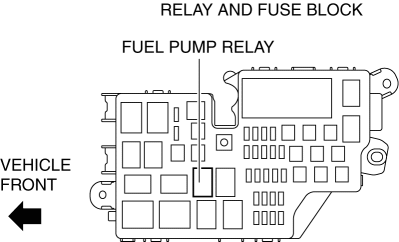Mazda 3 Service Manual: Fuel Line Pressure Inspection [Mzr 2.0, Mzr 2.5]
WARNING:
-
Fuel line spills and leakage from the pressurized fuel system are dangerous. Fuel can ignite and cause serious injury or death and damage. To prevent this, complete the following inspection with the engine stopped.
-
Fuel is very flammable liquid. If fuel spills or leaks from the pressurized fuel system, it will cause serious injury or death and facility breakage. Fuel can also irritate skin and eyes. To prevent this, always complete the “Fuel Line Safety Procedure”, while referring to the “BEFORE SERVICE PRECAUTION”.
-
A person charged with static electricity could cause a fire or explosion, resulting in death or serious injury. Before performing work on the fuel system, discharge static electricity by touching the vehicle body.
CAUTION:
-
Disconnecting/connecting the quick release connector without cleaning it may possibly cause damage to the fuel pipe and quick release connector. Always clean the quick release connector joint area before disconnecting/connecting using cloth or soft brush, and make sure that it is free of foreign material.
1. Complete the “BEFORE SERVICE PRECAUTION”..
2. Remove the battery cover..
3. Disconnect the negative battery cable..
4. Disconnect the quick release connector..

5. Turn the lever of the SST
parallel to the hose as shown in the figure.

6. Insert the SST
quick release connector into the fuel pipe until a click is heard.
7. Verify that the quick release connector is firmly connected by pulling it by hand.
8. Start the fuel pump using the following procedure.
-
Using M-MDS
-
Connect the negative battery cable..
-
Connect the M-MDS to the DLC-2.

-
Using the simulation function “FP”, start the fuel pump..
-
Without using M-MDS
-
Remove the fuel pump relay.

CAUTION:
-
Short the specified terminals because shorting the wrong terminal of the relay and fuse block may cause malfunctions.
-
-
Using a jumper wire, short fuel pump relay terminals C and D in the relay and fuse block.

-
Connect the negative battery cable and operate the fuel pump..
9. Operate the fuel pump for 10 s
.
10. Measure the fuel line pressure.
-
If not within the specification, inspect the following:
-
Fuel pump unit
-
Fuel line for clogging or leakage
-
Fuel line clogging
-
If it less than the specification:
-
If it exceeds the specification:
-
Fuel pressure
-
350—430 kPa {3.57—4.38 kgf/cm2, 50.8—62.3 psi}
11. Stop the fuel pump using the following procedure.
-
Using M-MDS
-
Using the simulation function “FP”, stop the fuel pump..
-
Without using M-MDS
-
Disconnect the negative battery cable to stop the fuel pump..
12. Measure the fuel hold pressure after 5 min
.
-
If not within the specification, inspect the following:
-
Fuel line leakage
-
Fuel hold pressure
-
210 kPa {2.14 kgf/cm2, 30.5 psi} or more
13. Complete the “BEFORE SERVICE PRECAUTION”..
14. Disconnect the SST
.
15. Connect the quick release connector..
16. Complete the “AFTER SERVICE PRECAUTION”..
 Fuel Injector Removal/Installation [Mzr 2.0, Mzr 2.5]
Fuel Injector Removal/Installation [Mzr 2.0, Mzr 2.5]
WARNING:
Fuel is very flammable liquid. If fuel spills or leaks from the pressurized
fuel system, it will cause serious injury or death and facility breakage. Fuel
can also irritate skin ...
 Fuel Pump Unit Disassembly/Assembly [Mzr 2.0, Mzr 2.5]
Fuel Pump Unit Disassembly/Assembly [Mzr 2.0, Mzr 2.5]
WARNING:
Fuel is very flammable liquid. If fuel spills or leaks from the pressurized
fuel system, it will cause serious injury or death and facility breakage. Fuel
can also irritate skin ...
Other materials:
Trunk Lid Release Actuator Inspection
1. Disconnect the negative battery cable..
2. Remove the trunk lid trim..
3. Remove the trunk lid latch and release actuator..
4. Press the latch in using a flathead screwdriver to inspect the latch lever
condition.
5. Connect terminal A to the positive battery voltage, connect termina ...
HVAC SST
49 B061 014
Spring Lock Coupling Disconnect Tool
49 G061 001
Spring Lock Coupling Disconnect Tool
49 B061 015A
Holder
49 0839 425C
Bearing puller set
49 SE01 160 ...
Vanity Mirror Illumination Bulb Removal/Installation
1. Disconnect the negative battery cable..
2. Insert a tape-wrapped fastener remover into the service hole, and pry it in
the direction indicated by the arrow to remove the lens.
3. Remove the vanity mirror illumination bulb.
4. Install in the reverse order of removal. ...
